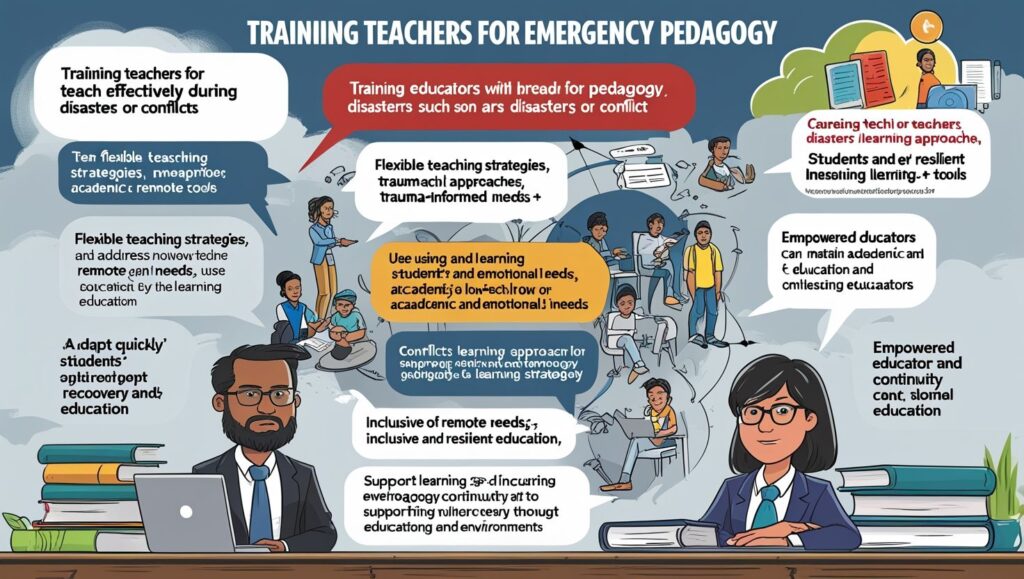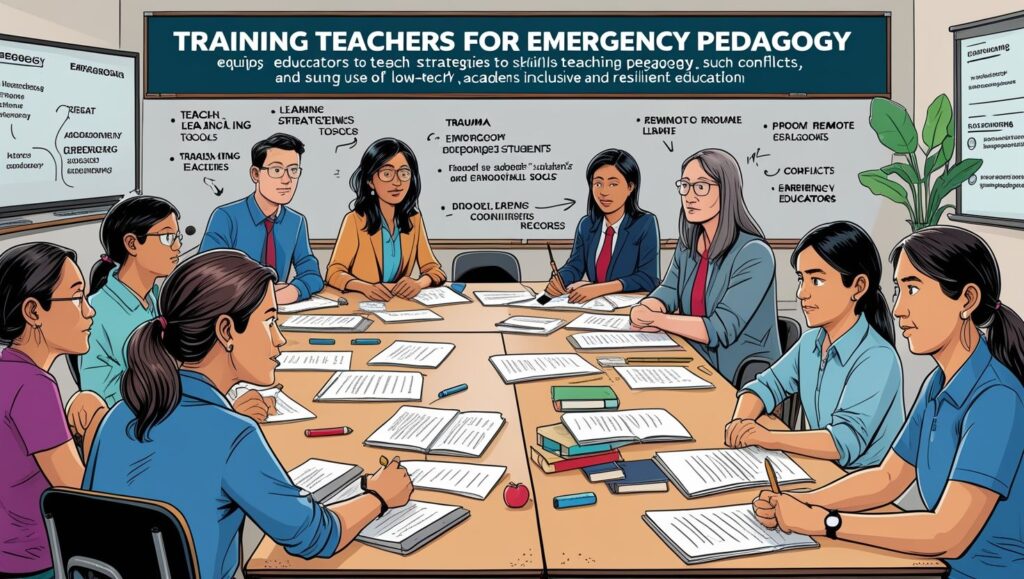Introduction
Training Teachers for Emergency Pedagogy in Education, Emergencies such as pandemics, natural disasters, and conflicts disrupt education systems worldwide. Consequently, teachers must be equipped with emergency pedagogy skills to ensure learning continuity. Emergency pedagogy refers to specialized teaching strategies that address crisis-related challenges. Without proper training, educators struggle to adapt, leading to learning loss. Therefore, investing in teacher preparedness is crucial. Governments, institutions, and organizations must collaborate to develop robust training programs. Additionally, these programs should focus on flexibility, resilience, and inclusivity. This article explores the importance of training teachers for emergencies. Furthermore, it examines key strategies, challenges, and solutions. By empowering educators, schools can maintain stability during crises. Ultimately, well-trained teachers foster student success despite disruptions.
Understanding Emergency Pedagogy
Emergency pedagogy adapts teaching methods to crisis conditions. Unlike traditional instruction, it emphasizes flexibility and trauma sensitivity. For instance, during disasters, lessons may shift online or to community spaces. Moreover, educators must address students’ emotional needs. Many children experience stress, anxiety, or displacement in emergencies. Therefore, teachers require skills in psychosocial support. Emergency pedagogy also involves using limited resources effectively. Radio broadcasts, printed materials, and mobile apps become essential tools. Furthermore, inclusive strategies ensure marginalized students are not left behind. Training programs must cover these diverse aspects. Thus, emergency pedagogy is a vital component of crisis-resilient education.
The Need for Teacher Training in Emergency Pedagogy
Teachers are frontline responders in educational crises. However, most lack formal training in emergency pedagogy. Without preparation, they face overwhelming challenges. For example, sudden school closures demand rapid shifts to remote teaching. Many educators struggle with technology or alternative delivery methods. Additionally, they must manage students’ trauma while coping with their own stress. Structured training programs can bridge these gaps. Workshops on digital tools, trauma-informed teaching, and adaptive curricula are essential. Furthermore, training fosters confidence and adaptability. When teachers are prepared, student learning continues smoothly. Hence, investing in professional development is a necessity, not an option.

Key Components of Emergency Pedagogy Training
Effective training programs should cover multiple critical areas. First, digital literacy ensures teachers can use online platforms effectively. Second, psychosocial support training helps educators address emotional distress. Third, flexible curriculum design allows adaptation to various learning environments. Additionally, risk management and safety protocols protect both teachers and students. Collaborative learning strategies, such as peer mentoring, enhance resilience. Scenario-based drills prepare educators for real-life emergencies. Furthermore, training should include gender-sensitive and inclusive teaching practices. By addressing these components, teachers become well-rounded crisis responders.
Challenges in Implementing Teacher Training Programs
Despite its importance, emergency pedagogy training faces obstacles. Limited funding restricts program scalability in many regions. Additionally, logistical issues, such as poor internet access, hinder online training. Teacher shortages further strain existing systems. Moreover, resistance to change may slow adoption of new methods. Cultural and language barriers complicate standardized training approaches. Without government support, initiatives lack sustainability. Therefore, addressing these challenges requires coordinated efforts. Partnerships with NGOs and international agencies can provide resources. Policymakers must prioritize teacher training in national education plans.
Successful Models of Emergency Teacher Training
Several countries have implemented effective training programs. For example, Finland integrates crisis preparedness into teacher education curricula. Similarly, Japan conducts regular disaster response drills for educators. In Rwanda, post-genocide teacher training emphasized trauma-informed practices. Furthermore, organizations like UNICEF and UNESCO support global training initiatives. These models highlight best practices, such as blended learning and community involvement. By studying successful examples, other nations can replicate adaptable frameworks.
The Role of Technology in Teacher Training
Technology enhances emergency pedagogy training through scalable solutions. Online courses allow self-paced learning for educators worldwide. Mobile apps provide just-in-time resources during crises. Virtual simulations prepare teachers for high-stress scenarios. Additionally, social media fosters peer support networks. However, digital divides limit access in low-resource areas. Therefore, hybrid approaches combining online and offline methods are ideal. Governments must invest in infrastructure to ensure equitable access.

Community and Stakeholder Involvement in Training
Sustainable training programs require community engagement. Local leaders can advocate for teacher support. Parents and volunteers assist in resource distribution. Furthermore, partnerships with universities strengthen training quality. Businesses may sponsor digital tools or connectivity solutions. When communities participate, training programs become more relevant and effective. Thus, collaboration ensures long-term success.
Policy Recommendations for Sustainable Training
Governments must institutionalize emergency pedagogy training. National education policies should mandate crisis preparedness modules in teacher colleges. Additionally, continuous professional development should include refresher courses. Funding allocations must prioritize teacher training in emergency budgets. Monitoring systems should evaluate program effectiveness. International cooperation can standardize training frameworks. With strong policies, teacher preparedness becomes systemic rather than reactive.
Conclusion
Training teachers in emergency pedagogy is essential for resilient education systems. Crises will continue to disrupt learning, but prepared educators can mitigate impacts. Comprehensive training programs must address digital skills, trauma support, and adaptive teaching. While challenges exist, collaborative solutions can overcome them. Governments, communities, and global organizations must work together. Ultimately, investing in teachers today ensures stable education for future generations.

Just wanna remark on few general things, The website pattern is perfect, the content material is very great. “Believe those who are seeking the truth. Doubt those who find it.” by Andre Gide.
levitra and sotalol levitra coupon levitra original
Just wanna comment that you have a very decent website , I enjoy the pattern it really stands out.
Hello very cool blog!! Man .. Excellent .. Wonderful .. I will bookmark your site and take the feeds also…I am satisfied to find so many useful information right here within the submit, we’d like work out more strategies in this regard, thank you for sharing. . . . . .
Thank you for the good writeup. It in fact was a amusement account it. Look advanced to more added agreeable from you! By the way, how could we communicate?